J.D. King, 1822 - 1908
by Brian Stevenson
last updated December, 2025
John Dudley King, of Massachusetts, USA, was a Methodist minister who was also a professional preparer of microscope slides and slide-making supplies, and a teacher of microscopical methods. His professional involvement appears to have begun around 1880, when he taught courses on microscopy at the Martha’s Vineyard summer school. Slides, finishing cements, and microtomes of his own devising were produced and marketed from the mid-1880s onward.
Due to his ministerial commitments, King moved frequently. Circa 1880, he was assigned to Edgartown, on the island of Martha’s Vineyard. All of his known advertisements provide an address of either Edgartown or the nearby Cottage City. Retention of a consistent postal address would have helped his business to flourish even when King was assigned to churches off the island (Somerset, 1884-86, and Fall River, 1887-90). He returned to the Edgartown church in 1891, then retired to Cottage City in 1894. He continued his microscopy business through the turn of the century.
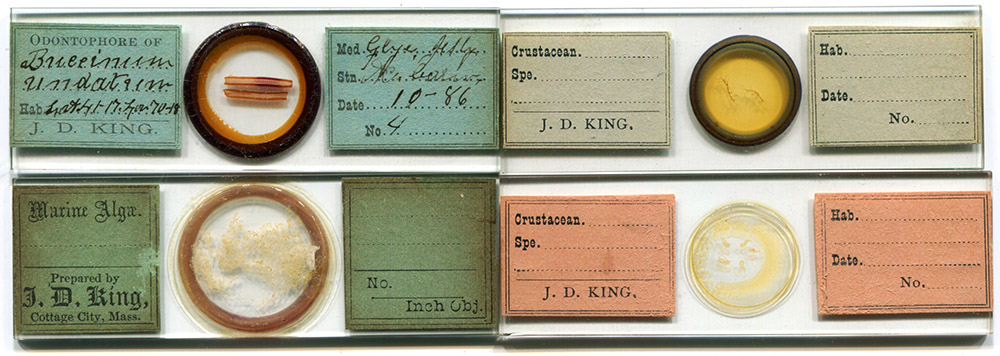
Figure 1.
Microscope slides from J.D. King. The top slide bears the address of Vineyard Grove, where King was a church organizer and real estate agent in the early 1870s. The lower left slide has his address of Cottage City, thereby dating it to after King’s retirement to that town in 1894. The slide on the upper right is dated October, 1886. The other slides without an address presumably also date from his years in Edgartown.
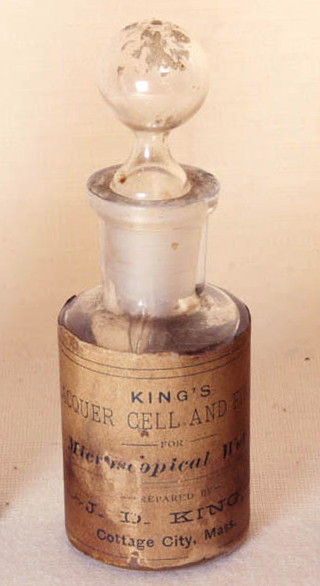
Figure 2.
A bottle of King’s Cement. The Cottage City address suggests manufacture between 1894 and the early 1900s. Adapted with permission from https://www.microscope-antiques.com/bandlkit.html.
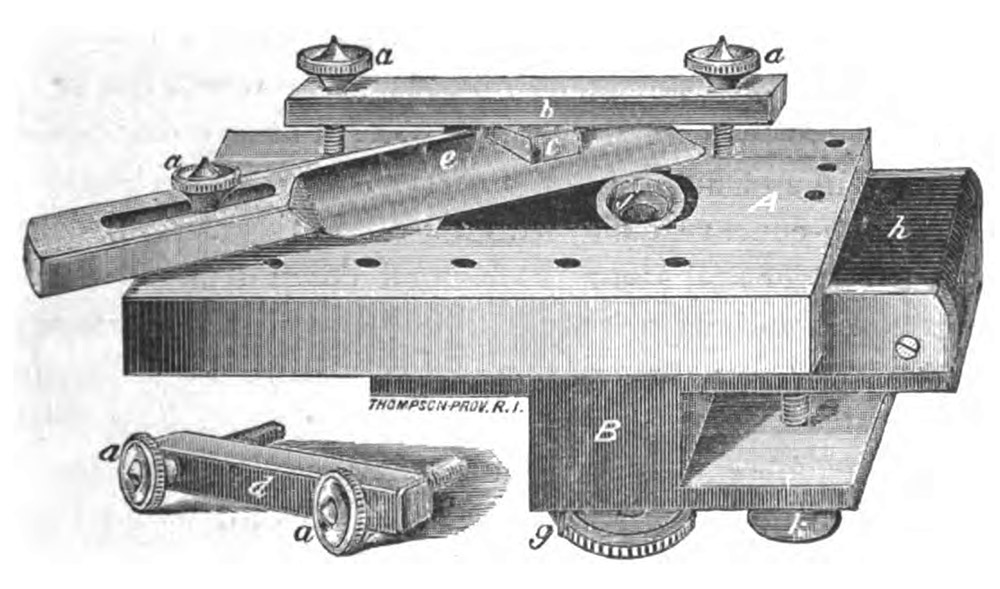
Figure 3.
1885 diagram of a microtome manufactured by J.D. King: “The Providence Microtome. So called from being the joint invention of several gentlemen of Providence, R.I. The original form was first designed by Mr. N.N. Mason of that city, who has used it for several years in zoological work. The instrument was perfected by Rev. J.D. King, Microscopist of the Martha's Vineyard Summer Institute, one of the gentlemen referred to, by whom it is manufactured and sold. In its present form it is perhaps equalled by no microtome made, for extreme precision of movement and consequent accuracy of performance in cutting sections. With a good knife in good order, sections of 10µ. to 25µ thick can be made without difficulty, and all alike.” Illustration and quote from W.J. Behrens’ “The Microscope in Botany: A Guide for the Microscopical Investigation of Vegetable Substances”. By 1889, King had ceased to manufacture the Providence microtome, and had replaced it with “simplified and improved” instrument, which he called “The King microtome” (see Figure 4).
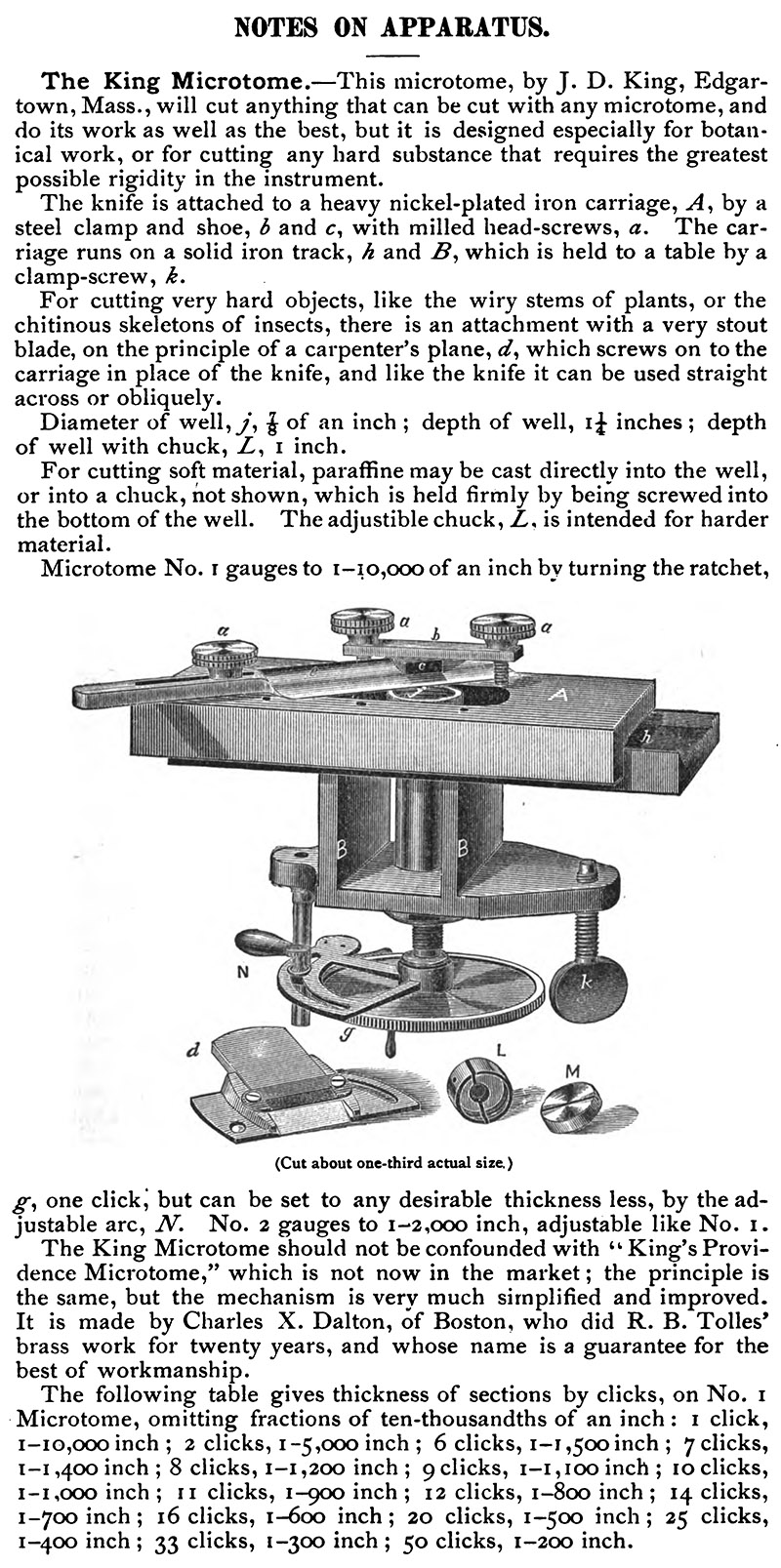
Figure 4.
An 1889 description and diagram of “The King microtome”, from "The American Monthly Microscopical Journal". The instrument is noted to have been manufactured by Charles X. Dalton, "of Boston, who did R. B. Tolles' brass work for twenty years, and whose name is a guarantee for the best of workmanship".
John Dudley King was born in Leicester, Massachusetts on January 21, 1822. He received a standard education at his local schools. After engaging in preaching for three years, he attended the Concord Biblical Institute in New Hampshire for one year. He was licensed as a minister in 1845, and was appointed as minister of the Methodist church in North Truro, Cape Cod, Massachusetts. He then served numerous 3-4 year stints throughout New England. King published offers to exchange microscope slides and material from Chatham in 1879 and Edgartown in 1880 and 1881 (Figure 5).
King married Mary Stetson on October 7, 1842. They had four children, two boys and two girls.
An area of Martha's Vineyard had become a popular site for religious camp revivals, and became known as Vineyard Grove. Over the years, people built houses and settled in the area. In 1870-72, J.D. King helped organize a regular church and Sunday school, as well as served as real estate agent to sell lots for houses. King's microscope slides with a "Vineyard Grove" address would date from this time (Figure 1). The burgeoning town separated from Edgarton in 1880, and incorporated as "Cottage City". The name was formally changed to "Oak Bluffs" in 1908.
The Martha’s Vineyard Summer Institute began in 1878, as a series of lectures on various topics, for the education of residents and tourists. Within a couple of years, it had developed into a destination for school teachers, students, and other people who wanted to broaden their knowledge. An advertisement for the 1880 session stated that it, “will commence on July 6, and continue five weeks, five days in the week. The members the first season numbered eighty students; the second, 170. The first year time were ten departments, or branches of study; the second year there were eleven departments. This season there will be fourteen departments, and upwards of eighteen professors”. Microscopy was taught by “Rev. J.D. King, of Edgartown”. King remained in charge of that topic until ca. 1893.
Associated with his scientific studies and teaching, King obtained B.S. and M.S. degrees from the Correspondence University, Chicago, and M.S. and Ph.D. degrees from National University, Chicago. He was appointed assistant professor and examiner at both institutions.
In addition to such teaching, King wrote detailed essays on microscopical methods, such as his 1881 “Mounting marine algae”.
Advertisements and descriptions of King’s microscope slides, slide-making supplies, and microtome began appearing in the mid-1880s. An 1885 note in Science reported that “Mr. J.D. King of Cottage City, Mass., director of the department of microscopy in the Martha's Vineyard summer institute, has prepared and offers for sale microscopic sections of the sixty species of Abietineae of the United States. The sections are cut as thin as practicable, varying from a hundredth to an eight-hundredth of an inch, and are so prepared by bleaching and double staining as to show the cross-section and the whole structure of the leaf very perfectly”. An article from the same year, on comparisons of commercial slide-making adhesives, noted, “King's cement, prepared by J.D. King, Cottage City, Mass., I have found to be a pleasant cement to finish mounts with. The label states that it is 'strong and reliable to attach cells and secure fluid mounts’”. The Journal of the Royal Microscopical Society highlighted a report by Mary Ann Booth, “a thoroughly reliable cement … the cement prepared by the Rev. J.D. King possesses all the desirable qualities of a universally useful cement. To lovers of the beautiful, King's scarlet or blue cement is pleasing to the eye, while that large class of microscopists to whom such beauty is a blemish will find in his amber cement reliability shorn of any objectionable features”.
King retired from the ministry in 1894, and lived his remaining years in Cottage City. The Observer noted in 1894, “After forty-eight years of ministerial work, Rev. J.D. King has been compelled by failing health to resign all pastoral labor. Microscopists will be glad to learn that Dr. King will continue his microscopical pursuits for the present, and that their cabinets may still be enriched by his perfect preparations”. Late that year, The Observer also reported, “We are glad to call attention to the newly issued catalogue by Dr. J.D. King, of Cottage City, Mass. … whose cements everybody knows, or should know. In addition to his various cements, staining fluids and mounting media, Dr. King gives a list of his excellent microscopical preparations. These include marine algae, mosses, ferns, vegetable sections, including conifers and leaves of conifers, rhizopodia, porifera, coelenterata, polyzoa, odontophores of mollusca, minerals and other objects allied to the classes above. From his connections with the Summer Institute, and his proximity to Wood’s Holl, Dr. King has had excellent opportunities for collecting, and schools and colleges needing preparations for illustration will find it for their interest to apply to Dr. King”.
An 1897 note in Meyer Brothers Druggist stated, “Dr. J.D. King of Cottage City, Massachusetts, has gained considerable reputation among microscopists on account of the superior quality of his cements and finishes. He is also the inventor of the King microtome, which is especially constructed for botanical work, and will answer admirably for pharmacists. While the doctor's name is familiar to so many workers with the microscope, no doubt but few have learned that this enthusiast with the instrument has celebrated his seventy-fifth birthday, and that he retired from the Methodist ministry four years ago after half a century work in the pulpit. The doctor always writes an interesting letter, and we trust that those of our readers who have microscopes will take advantage of an excuse for addressing the doctor and asking him for his circulars, etc.”.
The American Monthly Microscopical Journal reported in 1898, “We have just received a beautiful collection of slides from J.D. King, Ph.D., of Cottage City, Mass., and think they ought to please the most exacting. Send for his catalogue. Located on the very best part of the Atlantic coast he has unexcelled opportunities to gather marine specimens”. These slides included, “Evening Primrose, anther and pollen”, “Cuprite with native copper crystals”, “Bugula turrita with diatoms, expanded tentacles”, “Root of high blackberry”, “Asclepias, stained to show pitted ducts and spirals and not later tubes”, “Clematis virginiana. First and second year's growth”, “Leaf of Trias elastica, showing cystoliths”, “Transverse and longitudinal sections of mullen”, “Sasifras cut thick necessarily to show pitted ducts”, and “Pauperia, Soapwood from Brazil, full of crystals”.
King wrote an article on “The preparation and mounting of wood sections” for the Journal of Applied Microscopy in 1899. Advertisements from King continued until at least 1901 (Figure 11).
Wife Mary died on August 16, 1905. King re-married on April 4, 1906, to Emily F. Gardner Folger. J.D. King died on February 5, 1908, at the age of 86.

Figure 5.
Early microscope-related exchange offers from J.D. King. All from “The American Journal of Microscopy and Popular Science”.
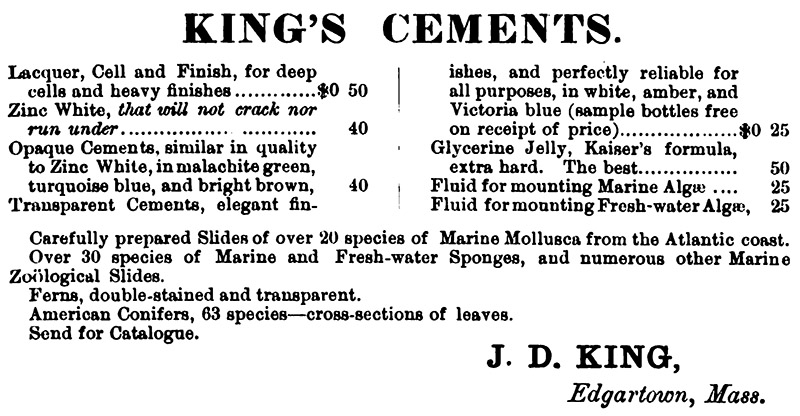
Figure 6.
An 1891 advertisement, from “The American Monthly Microscopical Journal”.
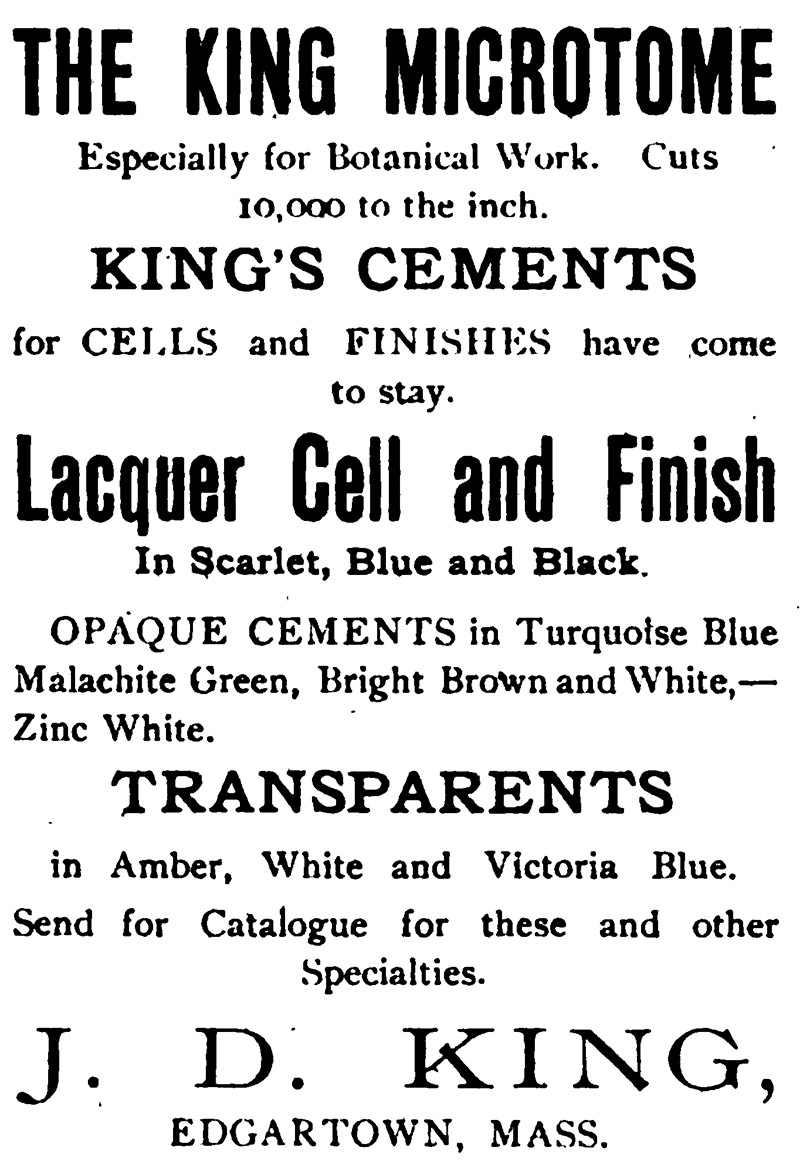
Figure 7.
An 1892 advertisement, from “The Observer”.

Figure 8.
An advertisement from 1894, the year that King retired to Cottage City. From “The Microscope”.
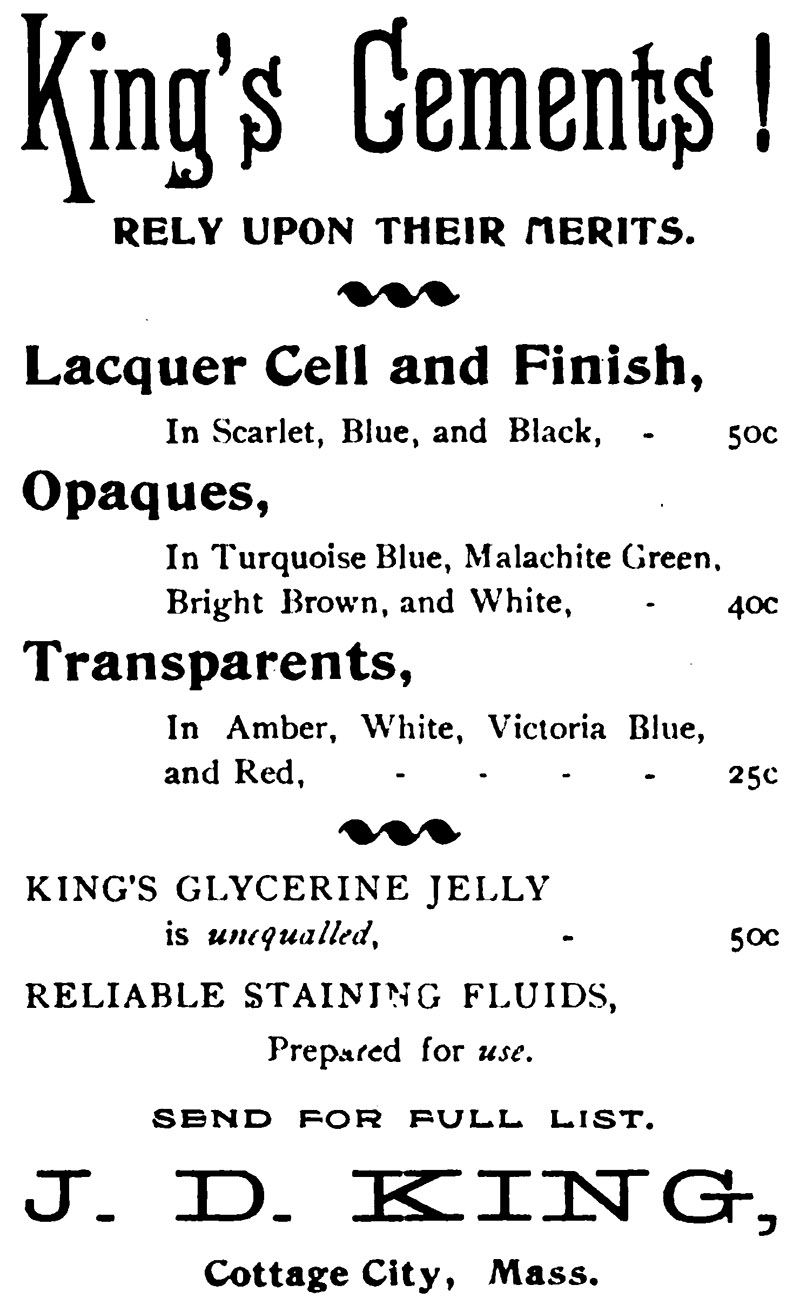
Figure 9.
An 1895 advertisement, from “The Observer”.
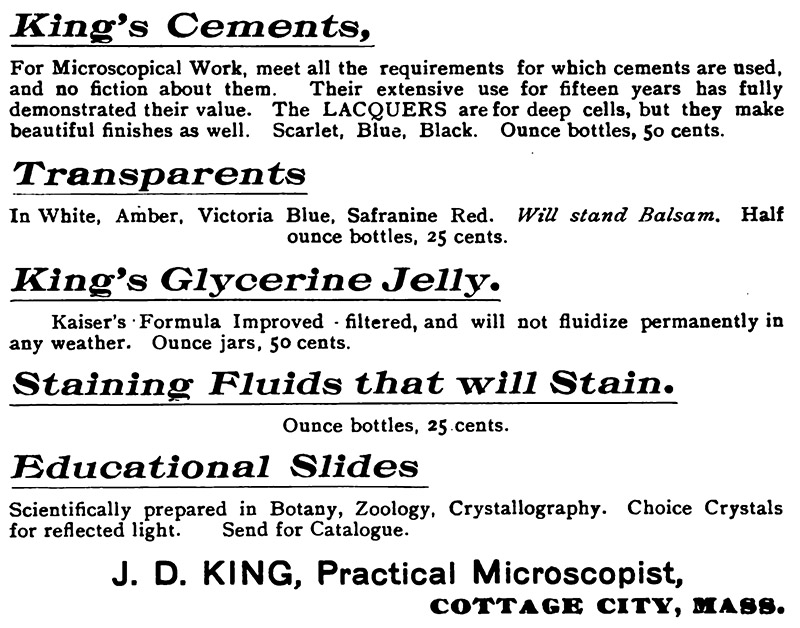
Figure 10.
An 1896 advertisement, from “Transactions of the American Microscopical Society”.

Figure 11.
1901 advertisement, from “The American Monthly Microscopical Journal”.
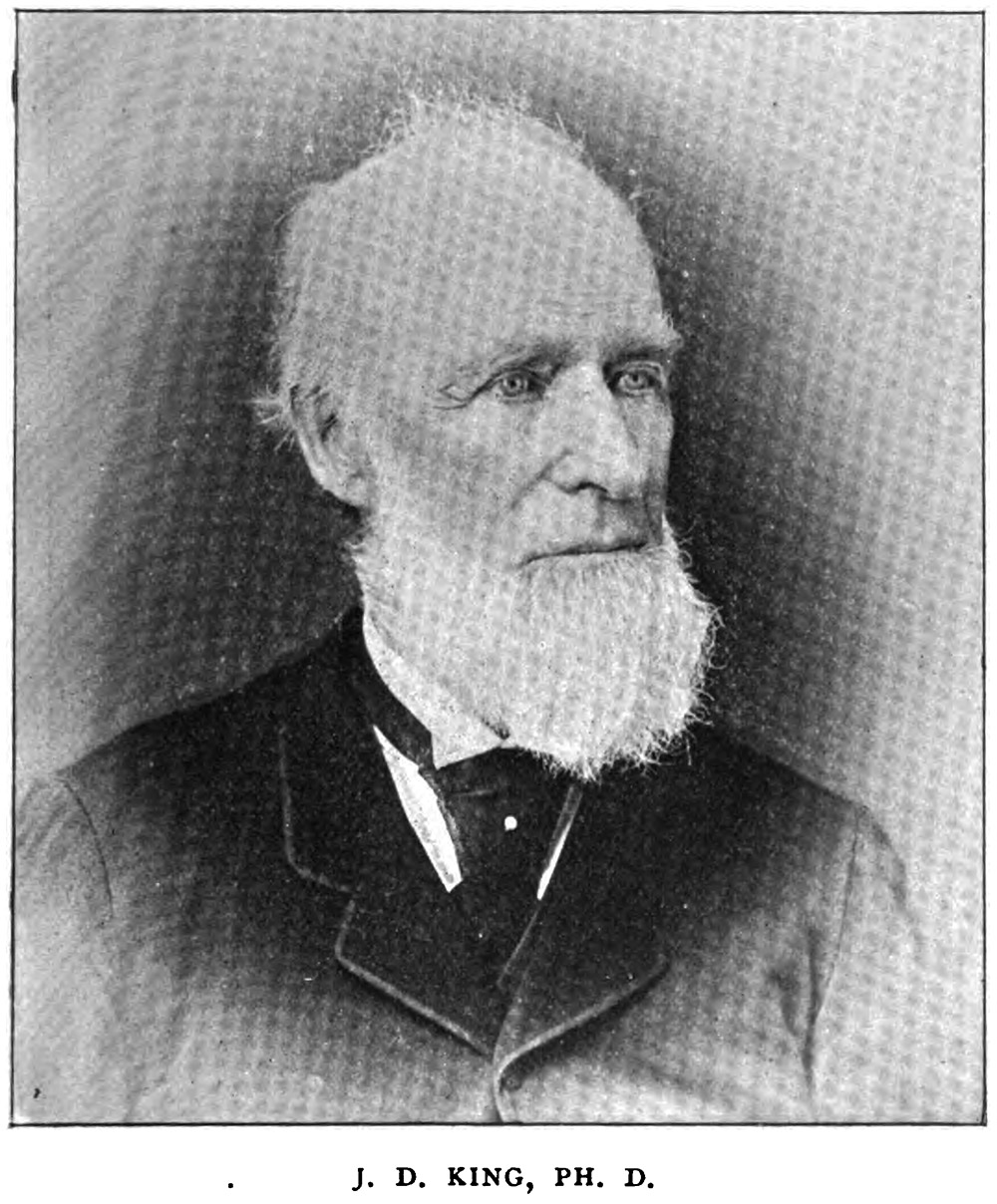
Figure 12.
An 1893 advertisement for the Martha’s Vineyard Summer Institute. J.D. King was director of the microscopy program from 1880 until 1893. From “The Journal of Education”.
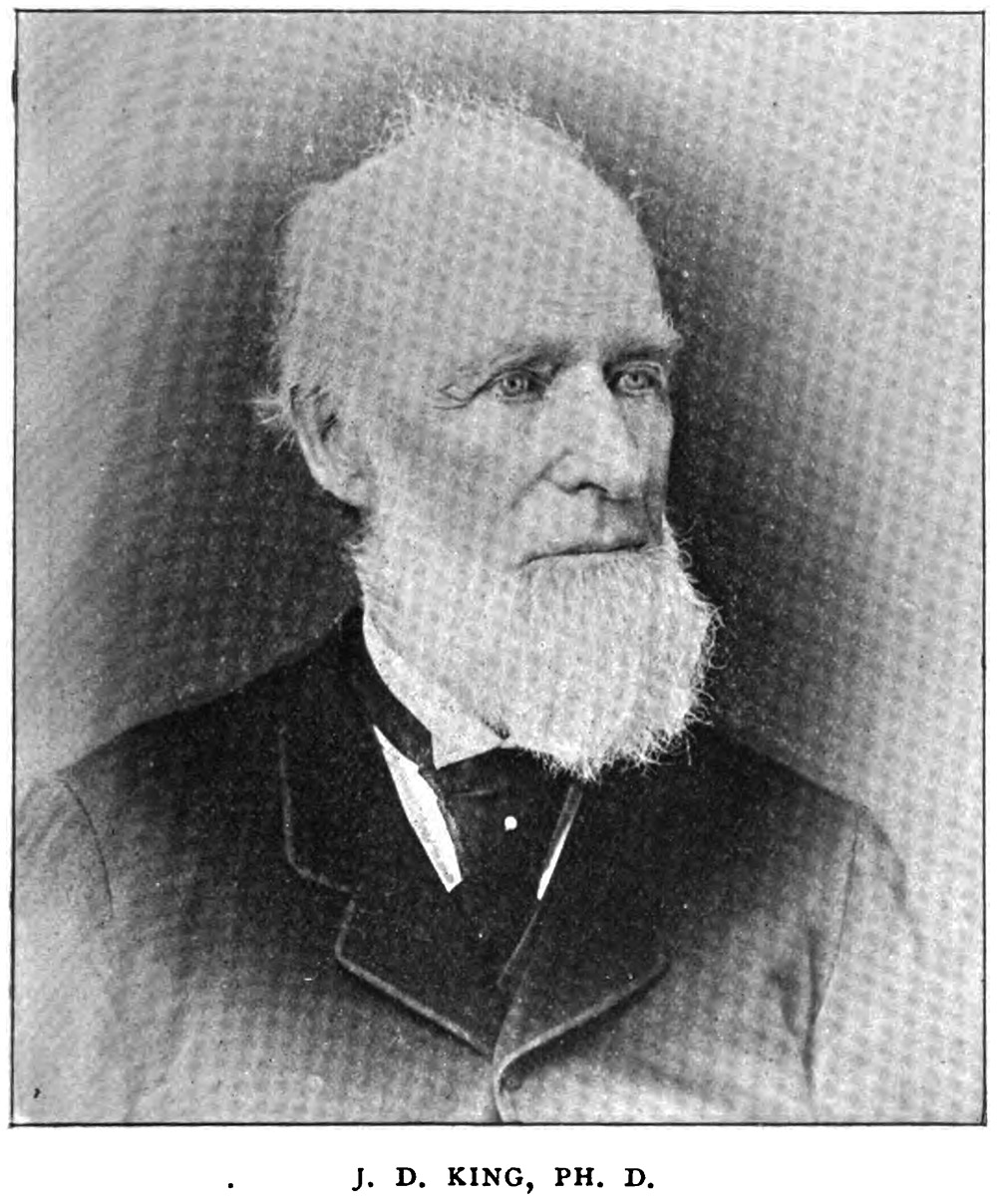
Figure 13.
A photograph of John D. King, which accompanied his 1896 article “The teeth of the mollusca and how they use them”, published in “The Observer”.
Acknowledgement
Thank you to Barry Sobel for sharing his photograph of a jar of King’s microscopical cement.
Resources
The American Journal of Microscopy and Popular Science (1879) Exchange offer from J.D. King, Vol. 4, page 48
The American Journal of Microscopy and Popular Science (1880) Exchange offer from J.D. King, Vol. 5, page 232
The American Journal of Microscopy and Popular Science (1881) Exchange offers from J.D. King, Vol. 6, pages 44 and 168
The American Monthly Microscopical Journal (1889) The King microtome, Vol. 10, pages 83-84
The American Monthly Microscopical Journal (1891) Advertisements from J.D. King, Vol. 12
The American Monthly Microscopical Journal (1892) Advertisements from J.D. King, Vol. 13
The American Monthly Microscopical Journal (1898) King’s slides, Vol. 19, pages 47, 68, and 180-181
The American Monthly Microscopical Journal (1899) Advertisements from J.D. King, Vol. 20
The American Monthly Microscopical Journal (1901) Advertisement from J.D. King, Vol. 22, May issue
Aubert, A.B. (1885) Results of experiments upon the adhesiveness of some microscopical cements, The American Monthly Microscopical Journal, Vol. 6, pages 227-229
Behrens, Wilhelm J. (1885) The Microscope in Botany, Translated by A.B. Hervey, Cassino & Co., Boston, pages 188-191
Death record of John Dudley King (1908) accessed through ancestry.com
The Educational Weekly (1880) Martha’s Vine Yard Summer Institute, Vol. 7, page 396
Journal of Education (1893) Advertisement from Martha’s Vineyard Summer Institute, Vol. 37, page 363
Journal of the Royal Microscopical Society (1887) King’s cement, page 1064
King, J.D. (1881) Mounting marine algae, The American Journal of Microscopy and Popular Science, Vol. 6, page 58
King, J.D. (1894) Preparation of fish scales, The Observer, Vol. 5, pages 18-19
King, J.D. (1894) The teeth of the Mollusca and how they use them, The Observer, Vol. 7, pages 529-534
King, J.D. (1894) King’s glycerine jelly, The Observer, Vol. 8, page 85
King, J.D. (1899) The preparation and mounting of wood sections, Journal of Applied Microscopy, Vol. 2, pages 461-464
Martha's Vineyard Museum (accessed December, 2025) A finding aid to the Florence and King families papers, https://www.mvmuseum.org/EAD_FindingAids/findingaid_get.php?record-unit=RU422
The Martha's Vineyard Times (2011) The story of Cottage City; “Let us go in peace”, February 16 issue, accessed through https://www.mvtimes.com/2011/02/16/story-cottage-city-let-us-go-peace-4549/
The Microscope (1893) Advertisements from J.D. King, New series, Vol. 1
The Microscope (1894) Advertisements from J.D. King, New series, Vol. 2
Meyer Brothers Druggist (1897) Dr. J.D. King, Vol. 18, page 64
Miller, Rennetts C. (1897) Souvenir History of the New England Southern Conference, Vol. 1, Miller, Nantasket, Massachusetts, pages 38, 71, 246, and 267
The Observer (1892) Advertisements from J.D. King, Vol. 3
The Observer (1892) “Apropos of cements, the Rev. J.D. King has just brought out a very dark brown cement, which will be especially acceptable to those who have found the conspicuousness of his scarlet cement an objectionable feature”, Vol. 3, page 193
The Observer (1892) Summer school, Vol. 3, page 194
The Observer (1894) Notes on J.D. King, Vol. 5, pages 318-319
The Observer (1895) Advertisements from J.D. King, Vol. 5
Science (1885) Vol. 5, page 81
Sutton, H.J. (1894) Permanent haematoxylin, The Observer, Vol. 5, page 224
Transactions of the American Microscopical Society (1894) Advertisements from J.D. King, Vol. 18, page x
U.S. census and other records, accessed through ancestry.com
Zion's Herald (1908) Translation of Dr. J.D. King, Vol. 86, page 200












